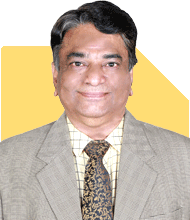Maxim Emmanuel |211 Answers |Ask -Follow
Soft Skills Trainer - Answered on Mar 26, 2024
An alumnus of the Xavier Institute of Management and Research, Mumbai, Maxim has over 30 years of experience in training young professionals and corporate organisations on how to improve soft skills and build interpersonal relationships through effective communication.
He also works with students and job aspirants offering career guidance, preparing them for job interviews and group discussions and teaching them how to make effective presentations.... more

Hi Sir/Madam, After my engineering degree in 1999, i got a job in a company through my uncle's influence. I could work only for 5 yrs and left the job...i went into depression and then my husband helped me to get out of the depression, got me another job, there also I couldnot handle the work pressure and left job in 10 months...then realised that i cannot do IT and left it..after one year my son was born. As he started going to school, i joined painting classes, i went to classes from 2011 to 2020, i just went to engage myself to these classes which i enjoyed...After 2 yrs of covid, i went back to tbe same painitng class, but this time i felt the tutor was irritated with me and didnt teach me properly and hence i looked out for other painting classes. I went to another place, where they charged more money and stopped going there...I again went to a third place, here the tutors are excellent, here what i realised was that all the past 10 years where i went for painting class was nothing compared to the new place where am going...I have lost confidence and i think am no where compared to the new tutors..I have lost hopes in life and again gone into depression..how do i come out of this depression...i like to teach painitng, but i dont have the confidence to teach too as i compare myself with other teachers and feel i should start learning painting again from scratch...plz help, what should I do next...
Failures are stepping stones to success, realise even GOLD is said as 99.99% purity.
Having said so I realise you have had a chequered past, with a few disappointments.
However I realise you have discovered new joy in your painting. In the quest for success, realise there will be set backs learn to roll the ball... it means get along with life.
Don't compare yourself with anyone, because are an ORIGINAL,remember no one will be like you.
A painter is never compared, each one has a masterpiece... Now coaching others in painting start classes for the young one's ..then go ahead from there..!
Have an exhibition of your and your students painting's.. You will realise you are really special!
You may like to see similar questions and answers below
Mayank Kumar |189 Answers |Ask -Follow
Education Expert - Answered on May 05, 2023
Maxim Emmanuel |211 Answers |Ask -Follow
Soft Skills Trainer - Answered on Apr 17, 2024
Maxim Emmanuel |211 Answers |Ask -Follow
Soft Skills Trainer - Answered on May 02, 2024
Ramalingam Kalirajan |2339 Answers |Ask -Follow
Mutual Funds, Financial Planning Expert - Answered on May 17, 2024
Ramalingam Kalirajan |2339 Answers |Ask -Follow
Mutual Funds, Financial Planning Expert - Answered on May 17, 2024
Ramalingam Kalirajan |2339 Answers |Ask -Follow
Mutual Funds, Financial Planning Expert - Answered on May 17, 2024
Ramalingam Kalirajan |2339 Answers |Ask -Follow
Mutual Funds, Financial Planning Expert - Answered on May 17, 2024
Ramalingam Kalirajan |2339 Answers |Ask -Follow
Mutual Funds, Financial Planning Expert - Answered on May 17, 2024
Ramalingam Kalirajan |2339 Answers |Ask -Follow
Mutual Funds, Financial Planning Expert - Answered on May 17, 2024
Ramalingam Kalirajan |2339 Answers |Ask -Follow
Mutual Funds, Financial Planning Expert - Answered on May 17, 2024
Ramalingam Kalirajan |2339 Answers |Ask -Follow
Mutual Funds, Financial Planning Expert - Answered on May 17, 2024
Ravi Mittal |193 Answers |Ask -Follow
Dating, Relationships Expert - Answered on May 16, 2024
Ravi Mittal |193 Answers |Ask -Follow
Dating, Relationships Expert - Answered on May 16, 2024















.jpg)






